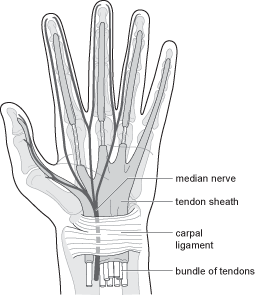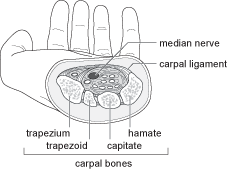Carpal tunnel syndrome - Causes and treatments
This factsheet is for people who have been diagnosed with or who suspect that they have carpal tunnel syndrome.
Carpal tunnel syndrome is a fairly common condition that occurs when there is too much pressure on a nerve in the wrist. There is usually aching, numbness or tingling in the thumb, some of the fingers and sometimes part of the hand.
About carpal tunnel syndrome
About 3 in 100 people develop carpal tunnel syndrome at some point in their life. Over half of these are women. While it can develop at any age, the chance of it occurring increases with age. It is most common in people in their 40s and 50s.
Sometimes carpal tunnel syndrome can be triggered by your job. It can sometimes be prevented by stopping or reducing the activity that stresses your fingers, hand, or wrist, or by changing the way in which activities are done.
What is the carpal tunnel?
The carpal tunnel is a channel in the palm side of the wrist (see diagram below). The bones of the wrist are arranged in a semi-circle, and a tough ligament called the transverse carpal ligament or flexor retinaculum forms a roof over them, creating a passageway (the carpal tunnel). Running through the carpal tunnel are the tendons that we use to bend the fingers and wrist, and the median nerve. This is one of three nerves that connect to the hand. The median nerve also controls some of the muscles that move the thumb.
What causes carpal tunnel syndrome?
Because there isn't much room in the carpal tunnel, any swelling around it can compress the median nerve, causing the symptoms of carpal tunnel syndrome.
What are the symptoms?
Symptoms include aching, tingling, "pins and needles", a swollen feeling, burning, numbness or pain in the hand and fingers. Only fingers served by the median nerve - the thumb, the index and middle fingers, and part of the ring finger - are affected (see diagram below). Sometimes, the symptoms can spread up your arm.
Carpal tunnel syndrome tends to be worse at night or first thing in the morning and is often made worse by strenuous wrist movements. You may find that you get temporary relief by hanging your arm out of the bed at night or by shaking your hand vigorously with a flicking action.
It can affect one or both hands to varying degrees. Symptoms may be mild or only occur from time to time, but if the condition worsens they may become constant. Your hand muscles may become weakened, making it difficult to grip objects or perform other manual tasks. In severe, long-lasting cases the thumb muscles may start to waste away or the median nerve may be permanently damaged.
Why does it happen?
For many people, it isn't known why carpal tunnel syndrome develops.
Some studies suggest that repeated activities requiring wrist movements can lead to inflamed tendons or swelling in the carpal tunnel, causing the condition. The movements may be related to your job or hobby, such as typing, knitting, manufacturing work or using small tools. People who use vibrating tools are particularly at risk.
The condition is more likely to develop if you have sprained or previously broken your wrist, which can lead to swelling. The carpal tunnel may also be compressed through rheumatoid arthritis, or in a condition where excess growth hormone is produced (called acromegaly).
Another cause is pressure within the tunnel due to fluid retention. This can happen if you have kidney failure, have an underactive thyroid, or are pregnant. Carpal tunnel syndrome is also more common in people who are very overweight, in women who are taking the contraceptive pill, and during the menopause.
It can be caused by changes to the median nerve itself, too, which may happen if you have diabetes or drink excessive amounts of alcohol.


Illustrations showing the carpal tunnel
To diagnose carpal tunnel syndrome, your doctor may carry out a nerve conduction test. To do this, wires are attached to your fingers and wrist, and small electric shocks applied. Your doctor can then assess nerve conduction and find out if there is any damage to the median nerve.
Treatment of carpal tunnel syndrome
Carpal tunnel syndrome treatment aims to relieve the symptoms by reducing the pressure on the median nerve. You should start your treatment as early as possible, under the guidance of your doctor.
Non-surgical treatments of carpal tunnel syndrome
Wrist splints are often recommended for use either at night, or both day and night. These help to keep your wrist straight and reduce pressure on the compressed nerve. Mild symptoms can be relieved by applying ice packs to your wrist and by resting your hands and wrists regularly. You shouldn't apply ice directly to the skin because it can cause frostbite - use a bag of frozen peas or a cold compress wrapped in cloth and apply it to your wrist for up to 20 minutes, every couple of hours.
If your condition is linked to the way you use your hands, it is important to try and avoid these actions. Changing the way repetitive movements are done, reducing how often you do them, and increasing the amount of rest between periods of activity should help.
Stretching exercises can help to relieve symptoms and keep the area mobile. Some studies indicate that nerve and tendon gliding exercises - exercises designed to relieve pressure on the median nerve - may also help to reduce symptoms, but the evidence is not conclusive.
Drugs
Over-the-counter non-steroidal anti-inflammatory drugs (NSAIDs) such as ibuprofen or aspirin may help by reducing swelling and relieving pain.
There are other medicines available for carpal tunnel syndrome that your doctor may prescribe you.
- Corticosteroid tablets (eg prednisolone) can provide relief by reducing swelling, but are known to have side-effects such as weight gain or high blood pressure when used for a long time.
- Injecting steroids (eg hydrocortisone) into the carpal tunnel can reduce swelling and give temporary relief from the symptoms.
Other treatments
Research indicates that ultrasound treatment can help reduce the symptoms of carpal tunnel syndrome. Yoga has also been shown to help with controlling symptoms in the short term.
Some studies suggest that taking vitamin B6 (pyridoxine) tablets can help reduce symptoms, but the evidence isn't conclusive.
In addition, some people with carpal tunnel syndrome find that acupuncture helps to reduce pain, but there is no scientific evidence to back this up.
Surgery for carpal tunnel syndrome
If your symptoms continue to get worse and the cause of the carpal tunnel syndrome can't be removed, your doctor may suggest carpal tunnel release surgery.
This operation involves cutting the carpal ligament to make more space for the nerves and tendons in the carpal tunnel. It can usually be done as day-case surgery. It can be carried out in two ways.
- Keyhole surgery - a thin flexible telescope (endoscope) is inserted into a small cut in the wrist allowing the surgeon to see inside the wrist and cut the carpal ligament.
- Open release surgery - a traditional open operation, where a longer cut of around 6cm is made in the wrist allowing the carpal ligament to be cut.
Endoscopic surgery leaves a smaller scar, and some studies suggest that it allows people to get back to their usual activities more quickly. However, there may be a slightly higher risk of nerve damage. Your doctor will advise you on the most suitable type of surgery for you.
Treatment outcomes
Carpal tunnel syndrome doesn't develop in a predictable way. In around one in three people with the syndrome, the condition simply gets better without any treatment.
Some people have symptoms that get progressively worse, while others only have symptoms from time to time. If treated early, mild cases usually get better without surgery.
It may improve when an underlying cause is removed, for example, after the end of a pregnancy, or when diabetes or an underactive thyroid is treated.
Most people will improve after surgery, but it can take several months to recover.
Further information
Sources
- Atroshi I, Gummesson C, Johnsson R, Ornstein E, Ranstam J, Rosén I. Prevalence of carpal tunnel syndrome in a general population. JAMA 1999; 282: 153-158
- Carpal Tunnel Syndrome. American Academy of Orthopaedic Surgeons.
www.aaos.org
accessed 20 July 2006
- Katz JN, Simmons BP. Carpal Tunnel Syndrome. N Engl J Med 2002; 23:1807-1812
- Netter FH. Atlas of Human Anatomy. 2nd edition. Canada: Daller II AF, 2001: 441
- Parmet S, Lynm C, Glass RM. Carpal Tunnel Syndrome - JAMA Patient Page. JAMA 2002; 288(10): 1310
- Carpal Tunnel Syndrome - About this condition. BMJ Clinical Evidence.
www.clinicalevidence.com
accessed 25 July 2006
- Carpel Tunnel Syndrome. The Arthritis Society.
www.arthritis.ca
accessed 26 July 2006
- Simon C, Everitt H, Birtwistle J, Stevenson B. Oxford Handbook of General Practice. 3rd ed. Oxford, 2004: 345
- Carpal Tunnel Syndrome Fact Sheet. National Institute of Neurological Disorders and Stroke.
www.ninds.nih.gov
accessed 25 July 2006
- Longmore M, Wilkinson IB, Rajagopalan S. Oxford Handbook of Clinical Medicine. 6th Ed. Oxford, 2004: 391
- Carpal Tunnel Syndrome. Arthritis Research Campaign.
www.arc.org.uk
accessed 25 July 2006
- Carpal Tunnel Syndrome FAQ. American Association for Hand Surgery.
www.handsurgery.org
accessed 25 July 2006
- Carpal Tunnel Syndrome - Physical therapy and Exercise. Mayoclinic.com.
www.mayoclinic.com
accessed 25 July 2006
- Non-surgical treatment (other than steroid injection) for carpal tunnel syndrome. The Cochrane Collaboration.
www.cochrane.org
accessed 25 July 2006

Latest health and fitness news
 All news stories
All news stories
Latest quizzes and tests
 All quizzes &
tests
All quizzes &
tests
|


